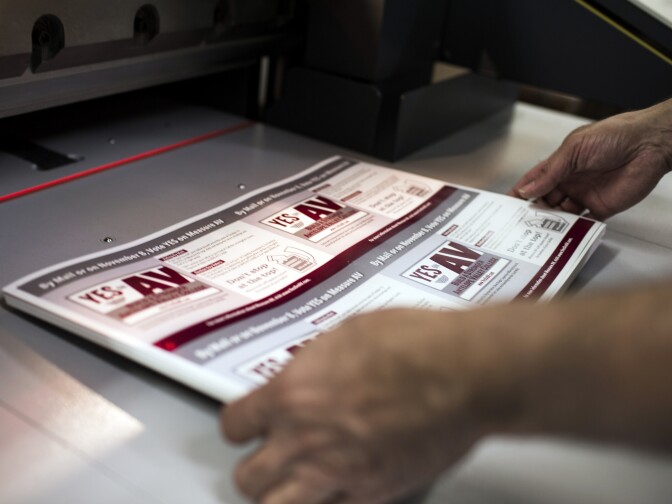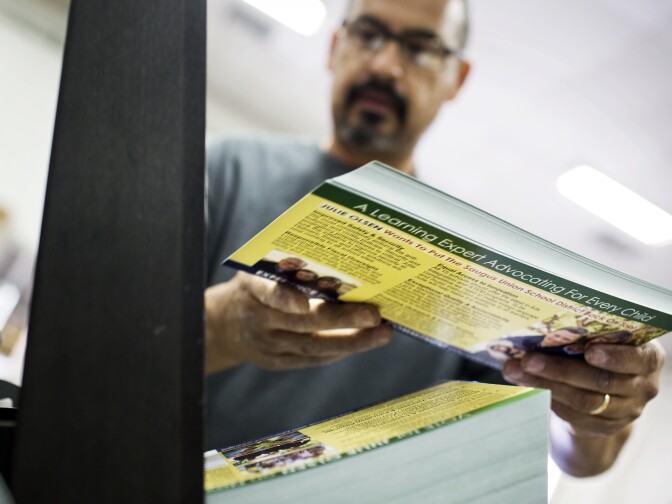With our free press under threat and federal funding for public media gone, your support matters more than ever. Help keep the LAist newsroom strong, become a monthly member or increase your support today.
Inside the high-tech, data-driven world of campaign mail
As election day draws near, campaign mailers are blanketing mailboxes all over California. While snail mail might not seem like the most sophisticated way to win an election, the depth of the strategy behind those mailers might surprise you.
"[They've] got ten seconds," said Thad Koussser, who teaches political science at UC San Diego. "[They've] got the time between someone's mailbox and someone's garbage bin to get their attention."
To do that, mailers use images and messaging that speak directly to the voter. Eye-popping colors, text and designs also help. And bigger is better — the glossy jumbo ones are simply too big to ignore.
It all starts with data
Before campaigns send out a mailer, they buy data on their voters. That helps strategists figure out who to target and what to tell them, said Darry Sragow, a longtime campaign strategist who helped get candidates like Diane Feinstein and Alan Cranston get elected.
Modern campaigns buy this information from firms like California's Political Data, which pull data from government sources, including county voter files and public records from the county assessor. They combine it with commercial data to give a rich picture of a person's demographic background and voting history.
That includes the basics like age and party affiliation. Campaigns can see when a voter typically casts a ballot, and stop sending mail to their home if their vote-by-mail ballots are already in. The data also includes educated guesses on a voter's race and ethnicity, based on an "ethnic dictionary" of names.
RELATED: KPCC fact-checks the claims on political mailers
A voter's address can offer the campaigns further clues. For example, Sragow said, if two voters of the same sex live together in an area with a large gay population, like West Hollywood, a campaign may send them mailers with messages highlighting LGBT issues.
This data isn't perfect. "You're not using a surgical scalpel, you're using a sledgehammer," Sragow said. "But a pretty good sledgehammer."
Fine-grained data allows campaigns to tailor colors, pictures and text to specific groups. "If you're mailing to senior citizens, you can have a picture of senior citizens. If you're mailing to parents whose kids are in elementary school, you can use the kids," Sragow said.
Hot off the presses
It's up to print shops to get mailers in front of voters.
"Whenever there's a political year we get excited," said Jill Mellady, owner of Mellady Direct in Santa Clarita.
Year-round, the company churns out flyers and postcards for schools, churches and car dealerships. But election season is like Christmas.
On a recent morning, Mellady's machines buzzed as workers darted around the warehouse floor.
Mellady thinks her shop could print a million and a half political mailers this year. At more than fifty cents and sometimes up to $2 per mailer, it's good business for her company.
The mailers collected through KPCC's #WhoMailedIt project vary greatly in size
Her machines can print, cut and sort thousands of pieces per hour. One device does nothing but fold paper, and another dries the freshly-printed addresses with infrared light.
Printing software makes sure the mail comes off the presses in the exact order that a USPS carrier will eventually deliver it. Workers here slap a red tag on boxes that says "political campaign mailing," and it's ready to go.
The last thing to consider: timing. Mellady says her political clients are extremely picky about when mail goes out.
"We try to mail on specific days," she said. "Make sure that it's not getting delivered on the day that all the other mailers, like the flyers from all the grocery stores [go out]."
Signed, sealed, delivered — and stacking up
Sragow said all the hard work that goes into creating mailers is worth it. He saw effective mailers tip the scales in campaigns when he directed election strategy for democrats in the state assembly.
Or as UC San Diego's Thad Kousser put it: "the smartest California consultants have been fighting out these races through mailers for the last three decades. So they're probably doing something right."
That means that even in the digital era, glossy snail mail is likely to remain an important part of modern campaigns – but not necessarily national campaigns. Mailers are most often used for local races, like school board, city council and state legislative offices.
That's because local candidates don't have many other advertising options. TV ads are too pricey, especially in markets like Los Angeles and the Bay Area. On top of that, broadcast ads reach people who live outside a political district and aren't able to vote for the candidate.
And while Sragow values mailers as a campaign consultant, he admits he doesn't like getting them at home.
"As a citizen and a voter, I found all the political mail to be really annoying," he said.
So annoying that in 2014, he saved all of the mailers that were delivered to his mailbox. After Election Day, he weighed the stack — it came in at a whopping seven pounds.
















